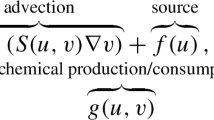Abstract
We study kinetic models for chemotaxis, incorporating the ability of cells to assess temporal changes of the chemoattractant concentration as well as its spatial variations. For prescribed smooth chemoattractant density, the macroscopic limit is carried out rigorously. It leads to a drift equation with a chemotactic sensitivity depending on the time derivative of the chemoattractant density. As an application it is shown by numerical experiments that the new model can resolve the chemotactic wave paradox. For this purpose, the macroscopic equation is coupled to a simple activation-inhibition model for the chemoattractant which produces the chemoattractant waves typical for the slime mold Dictyostelium discoideum.
Similar content being viewed by others
References
Alcantara, F., Monk, M.: Signal propagation during aggregation in the slime mold Dictyostelium discoideum. J. Gen. Microbiol. 85, 321–334 (1974)
Alt, W.: Biased random walk models for chemotaxis and related diffusion approximations. J. Math. Biol. 9 (2), 147–177 (1980)
Chalub, F., Markowich, P., Perthame, B., Schmeiser, C.: Kinetic models for chemotaxis and their drift-diffusion limits. Monatsh. Math., 2004
Dallon, J., Othmer, H.G.: A discrete cell model with adaptive signalling for aggregation of Dictyostelium aggregation. Phil. Trans. R. Soc. Lond. B, 352, 391–417 (1997)
Filbet, F., Laurencot, P., Perthame, B.: Derivation of hyperbolic models for chemosensitive movement. J. Math. Biol. 50 (2), 189–207 (2005)
Geiger, J., Wessels, D., Soll, D.: Human polymorphonuclear leukocytes respond to waves of chemoattractant, like Dictyostelium. Cell Motil. Cytoskeleton, 56, 27–44 (2003)
Hillen, T.: Hyperbolic models for chemosensitive movement. Math. Models Methods Appl. Sci. 12 (7), 2002
Hillen, T.: Transport equations with resting phases. European J. Appl. Math., In print
Hillen, T.: On the L 2-moment closure of transport equations: The Cattaneo approximation. Discr. Cont. Dyn. Systems, Series B, 2004, to appear
Hillen, T., Othmer, H.G.: The diffusion limit of transport equations derived from velocity jump processes. SIAM J. Appl. Math. 61 (3), 751–775 (2000)
Höfer, T., Maini, P.K., Sherratt, J.A., Chaplain, M. A., Chauvet, P., Metevier, D., Montes, P.C., Murray, J.D.: A resolution of the chemotactic wave paradox. Appl. Math. Lett. 7 (2), 1–5 (1994)
Höfer, T., Sherratt, J.A., Maini, P.K.: Cellular pattern formation during Dictyostelium aggregation. Physica D, 85, 425–444 (1995)
Keller, E.F., Segel, L.A.: Initiation of slime mold aggregation viewed as an instability. J. Theor. Biol. 26, 399–415 (1970)
Martiel, J.L., Goldbeter, A.: A model based on receptor desensitization for cyclic AMP signalling in Dictyostelium cells. Biophys. J. 52, 807–828 (1987)
Murray, J.D.: Mathematical Biology. Springer, 1989
Othmer, H.G., Dallon, J.: A continuum analysis of the signal seen by Dictyostelium discoideum. J. Theor. Biol. 19, 461–483 (1998)
Othmer, H.G., Dunbar, S.R., Alt, W.: Models of dispersal in biological systems. J. Math. Biol. 26, 263–298 (1988)
Othmer, H.G., Hillen, T.: The diffusion limit of transport equations II: Chemotaxis equations. SIAM J. Appl. Math. 62 (4), 1222–1250 (2002)
Othmer, H.G., Schaap, P.: Oscillatory cAMP signaling in the development of Dictyostelium discoideum. Comm. Theor. Biol. 5, 175–282 (1998)
Patlak, C.S.: Random walk with persistence and external bias. Bull. Math. Biophys. 15, 311–338 (1953)
Poupaud, F.: Runaway phenomena and fluid approximation under high fields in semiconductor kinetic theory. ZAMM Z. Angew. Math. Mech. 72 (8), 359–372 (1992)
Poupaud, F., Rascle, M.: Measure solutions to the linear multi-dimensional transport equation with non-smooth coefficients. Comm. Partial Diff. Eq., 22 (1–2), 337–358 (1997)
Rappel, W.J., Thomas, P.J., Levine, H., Loomis, W.F.: Establishing direction during chemotaxis in eukaryotic cells. Biophysical J. 83, 1361–1367 (2002)
Rivero, M., Tranquillo, R., Buettner, H., Lauffenburger, D.: Transport models for chemotactic cell populations based on individual cell behavior. Chem. Eng. Sci. 44 (12), 2881–2897 (1989)
Soll, D.R.: Behavioral studies into the mechanism of eukaryotic chemotaxis. J. Chem. Ecol. 16, 133–150 (1990)
Stroock, D.W.: Some stochastic processes which arise from a model of the motion of a bacterium. Probab. Theory and Related Fields, 28, 305–315 (1974)
Tang, Y., Othmer, H.G.: A G-protein based model of adaption in Dictyostelium discoideum. Math. Biosci. 120, 25–76 (1994)
Tang, Y., Othmer, H.G.: Excitation, oscillations and wave propagation in a G-protein based model of signal transduction in Dictyostelium discoideum. Phil. Trans. R. Soc. Lond. B 349, 179–195 (1995)
Varnum, B., Edwards, K., Soll, D.R.: Dictyostelium amoebae alter motility differently in response to increasing versus decreasing temporal gradients in cAMP. J. Cell Biol. 101, 1–5 (1985)
Varnum, B., Edwards, K., Voss, E., Soll, D.R.: Amebae of Dictyostelium discoideum respond to an increasing temporal gradient of the chemoattractant cAMP with a reduced frequency of turning: evidence for a temporal mechanism in amoeboid chemotaxis. Cell Motil. Cytoskeleton 8, 7–17 (1987)
Varnum, B., Voss, E., Soll, D.R.: Frequency and orientation of pseudopod formation of Dictyostelium discoideum amoebae chemotaxing in a spatial gradient: further evidence for a temporal mechanism. Cell Motil. Cytoskeleton 8, 18–26 (1987)
Wessels, D., Murray, J., Soll, D.R.: Behaviour of Dictyostelium amoebae is regulated primarily by the temporal dynamics of the natural cAMP wave. Cell Motil. Cytoskeleton 23, 145–156 (1992)
Author information
Authors and Affiliations
Corresponding author
Rights and permissions
About this article
Cite this article
Dolak, Y., Schmeiser, C. Kinetic models for chemotaxis: Hydrodynamic limits and spatio-temporal mechanisms. J. Math. Biol. 51, 595–615 (2005). https://doi.org/10.1007/s00285-005-0334-6
Received:
Revised:
Published:
Issue Date:
DOI: https://doi.org/10.1007/s00285-005-0334-6




